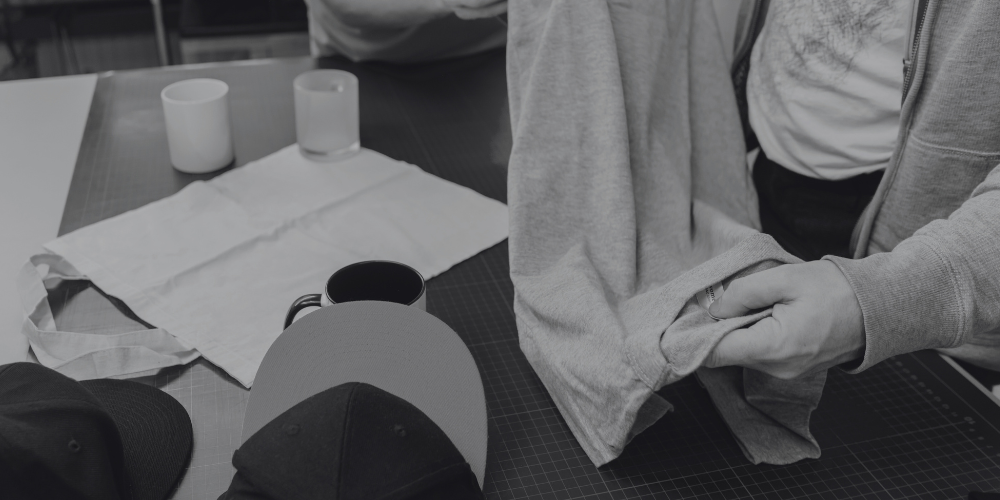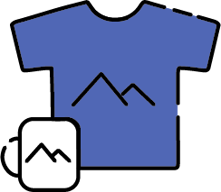Branded apparel is tremendously popular amongst our customers. It’s the go-to gift for employees, partners, customers, event attendees—just about anyone they will interact with. Whether it’s a brand-name polo shirt or a baseball cap, a high-end jacket or a t-shirt, branded apparel is a great way to advertise the brand while letting the recipient know they are valued.
Picking the right item for the occasion is fairly easy for our customers; they usually know exactly what they are looking for. Selecting the right material or fabric, though, is a bit more difficult. There are so many options that understanding the differences between them requires a fair amount of knowledge. It’s not uncommon for customers to be delighted with their selection but disappointed in the material they chose.
To help educate our users, we’re providing this high-level overview of the various materials or fabrics available. Not only will we explain the differences between them, we will also suggest the best application for each so that you can make future selections with confidence.
Here we go.

Cotton
Perhaps the most popular—and well known—fabric is cotton. A natural fiber that has been around for thousands of years, cotton is used in a wide variety of clothing items such as shirts, pants, dresses, socks, and more.
Cotton is popular because it’s comfortable, absorbent, versatile, breathable, and durable. As a natural fiber, it is also environmentally friendly—an important feature for many companies.
There are many different types of cotton, each optimized for a particular use. These include:
Ring spun
 Ring-spun cotton is a method of spinning cotton fibers into yarn, resulting in a softer, smoother, more durable fabric compared to open-end cotton. Ring-spun cotton is commonly used for high-end and premium-quality clothing items such as T-shirts, polo shirts, and other apparel where softness and durability are desired. While ring-spun cotton typically costs more than open-end cotton, many consumers consider it worth the investment due to its superior quality.
Ring-spun cotton is a method of spinning cotton fibers into yarn, resulting in a softer, smoother, more durable fabric compared to open-end cotton. Ring-spun cotton is commonly used for high-end and premium-quality clothing items such as T-shirts, polo shirts, and other apparel where softness and durability are desired. While ring-spun cotton typically costs more than open-end cotton, many consumers consider it worth the investment due to its superior quality.
Combed
Combed cotton has been subjected to a special manufacturing process that refines and prepares the fibers for spinning into yarn, resulting in a more luxurious, higher-quality cotton yarn. Like ring-spun cotton, combed cotton is typically used in high-quality and premium clothing items including T-shirts, dress shirts, bed linens, and undergarments—anything where softness and durability, combined with a refined appearance, are important. Many people consider combed cotton worth the investment for its superior quality and comfort.
Twill
Cotton twill, characterized by its distinct diagonal weave pattern, is a popular, versatile, and rugged textile typically used for caps and hats. The diagonal pattern is created by weaving the fabric in a way that produces ribbing effect on the surface, resulting in a distinct appearance that is also durable and comfortable. Its ability to withstand heavy use and its classic look have made it a timeless fabric.
Canvas
Cotton canvas is a heavy-duty, woven fabric known for its strength, durability, and sturdiness. Cotton canvas is particularly prized for its ability to withstand wear and tear, which is why it's commonly used for items that need to be rugged and long-lasting—things such as tents, bags, luggage, workwear, and other outdoor gear. Canvas comes in various weights and finishes, offering versatility for different applications and making it a very popular material.
Polyester
Most people are familiar with polyester, a synthetic polymer used to make various textiles and apparel. A type of plastic derived from petroleum, polyester is known for its durability, wrinkle-free nature, and resistance to moisture and chemicals.
Although most polyester is the same, there are different ways to prepare the material for production. These include the following techniques.
Pique
"Piqué" (pronounced pee-KAY) describes a particular weave or fabric texture characterized by a raised textured pattern produced by a special weaving technique that involves a combination of raised cords or patterns and recessed areas. This textured surface gives piqué fabric a unique look and feel that is commonly used in clothing items, particularly sportswear and casual wear.
Although not exclusive to polyester, the term “polyester piqué” means that the fabric was made from polyester fibers. Polyester piqué fabric offers several advantages, including durability, moisture-wicking properties, and resistance to wrinkles and shrinkage, making it ideal for polo shirts, sportswear, and other garments where a textured or breathable fabric is desired.
Ripstop
Ripstop describes a type of fabric designed to resist tearing or ripping. Ripstop fabrics can be made from various synthetic and natural materials, including polyester.
 The key feature of ripstop fabric is its grid-like pattern of reinforcement threads woven into the fabric. These thicker threads, often in a crosshatch pattern, are integrated into the fabric at regular intervals to provide additional strength and prevent tears or rips from spreading. If a tear or puncture occurs in ripstop fabric, it is less likely to progress beyond the grid pattern.
The key feature of ripstop fabric is its grid-like pattern of reinforcement threads woven into the fabric. These thicker threads, often in a crosshatch pattern, are integrated into the fabric at regular intervals to provide additional strength and prevent tears or rips from spreading. If a tear or puncture occurs in ripstop fabric, it is less likely to progress beyond the grid pattern.
Ripstop fabrics are commonly used in materials where durability and resistance to tearing are important. These include outdoor gear, camping equipment, military and tactical gear, sports and recreation items, and luggage and bags.
Post-consumer recycled
When used in relation to polyester, post-consumer recycled (PCR) refers to the process of collecting, processing, and reusing materials that have been discarded by their owners. In short, it is taking polyester products that have reached the end of their useful life and recycling them into new polyester products.
The use of post-consumer recycled polyester is more environmentally friendly than producing new polyester from raw petroleum-based materials since it reduces demand for new resources, lowers energy consumption, and minimizes the environmental impact.
Recycling polyester also contributes to sustainability efforts by reducing waste in landfills and lowering the carbon footprint associated with the production of new materials. As a result, many manufacturers are incorporating post-consumer recycled polyester into their products to confirm their commitment to sustainability.
Spandex/Elastane
Spandex, commonly known as elastane in Europe and other regions, is a synthetic fiber known for its exceptional elasticity. Spandex is not a specific type of fabric but rather a type of fiber that is blended with other fibers to create stretchy and form-fitting textiles.
Spandex is commonly used in clothing items like swimwear, activewear, leggings, sportswear, underwear, and other form-fitting garments. It is also used in products like elastic bands, waistbands, and compression garments.
It’s important to note that the brand name Lycra is often confused with spandex or elastane. However, spandex or elastane is the generic term used to describe fiber itself, while Lycra is a trademarked name for fibers produced by The LYCRA Company.
Regardless of the name, spandex/elastane is a crucial component in modern clothing, providing the flexibility, comfort, and stretch needed in many different types of apparel.
Nylon
Nylon, a synthetic polymer developed in the 1930s, is commonly used in a wide range of applications due to its strength, durability, weight, resistance to abrasion and chemicals, low moisture absorption, and flexibility. Its properties make it a valuable choice for products that require thermal stability and flexibility.
Dura Fabric
Dura fabric is a type of fabric designed for durability and long-lasting performance. While it is not a specific fabric type like cotton, polyester, or nylon, dura fabric describes any material that is particularly durable or resistant to wear and tear.
Sherpa-lined
Sherpa-lined apparel refers to clothing that incorporate a lining made of sherpa fabric—a synthetic material designed to mimic the look and feel of sheep's wool or shearling. Sherpa fabric features a soft, plush texture with a thick pile, making it exceptionally warm and cozy. Sherpa-lined apparel and accessories are favored for their ability to keep individuals warm and comfortable, making them perfect for outdoor activities, winter sports, and everyday wear during colder seasons. "Sherpa" is named after the Himalayan ethnic group known for their mountaineering skills and who have a tradition of wearing warm, woolen clothing.
Fleece
Fleece is a synthetic fabric known for its softness, warmth, and insulating properties, making it ideal for clothing, blankets, and other cold-weather gear. Although typically made from polyester fibers, some variations of fleece may incorporate other synthetic materials or blends.
Fleece is a versatile fabric that excels in providing warmth, comfort, and moisture management, making it a popular choice for outdoor enthusiasts and athletes who engage in outdoor activities under harsh and frigid conditions.
Many different types of fleece are available. Polar fleece, known for its warmth and softness, is typically found in jackets, blankets, and other cold-weather accessories. Micro fleece is a lightweight variation that is normally used in base layers, thermal underwear, and thin jackets to conserve heat without bulk. Berber fleece is a textured, high-pile surface resembling sheep's wool that is used for plush blankets and cozy, warm jackets. Finally, anti-pill fleece is treated to resist pilling (the formation of small, fuzzy balls on the surface).
Acrylic
Acrylic fabric, like polyester, is a lightweight, quick-drying synthetic material made from polymer fibers derived from petroleum-based chemicals. It is known for its softness, warmth, and wool-like appearance, making it a popular alternative to natural wool. While acrylic fabric has many advantages, as a synthetic fiber, it may not have the same breathability or moisture-wicking capabilities as natural fibers like cotton or wool, and it doesn’t offer the natural feel of wool. Nonetheless, acrylic fabric remains a popular choice for cold-weather clothing thanks to its affordability, versatility, and performance characteristics.
Rayon
Rayon, also known as viscose rayon, is a semi-synthetic fiber made from cellulose—a material primarily made from wood pulp, but which can also be derived from other plant-based materials like bamboo and sugarcane. Although it originates from plants, rayon is considered semi-synthetic because it must undergo significant chemical processing to transform cellulose into a usable textile fiber.
Rayon is noted for its softness, breathability, versatility, affordability, and its resemblance to natural fibers like silk, making it a popular choice in the fashion and textile industries. However, rayon does have limitations in terms of durability and may require special laundering to maintain its appearance and characteristics.
Modal
Modal fabric, a semi-synthetic textile made from the cellulose fibers of beech trees, is considered a variant of rayon and is often referred to as "modal rayon." Known for its softness, smooth texture, and excellent moisture-wicking properties, modal fabric is often used in the production of comfortable and breathable clothing such as underwear, pajamas, and T-shirts. Modal is also known for its ability to drape well and retain its color, and is considered more environmentally friendly than other synthetic fibers because it is derived from a renewable resource that minimizes its environmental impact.
Multiple Choices; One Vendor
As you can see, there are many different types of fabrics at your disposal, each offering different advantages and price points. By doing a little research, you can identify the right material for your next project, ensuring the next batch of branded apparel looks, feels, and costs exactly as you imagined.
Whatever you’re looking for, OnFulfillment can help you find, source, and produce your branded corporate apparel. We have relationships with vendors of all types and price ranges, including recognized brand names, which means we have access to anything you might be looking for.




